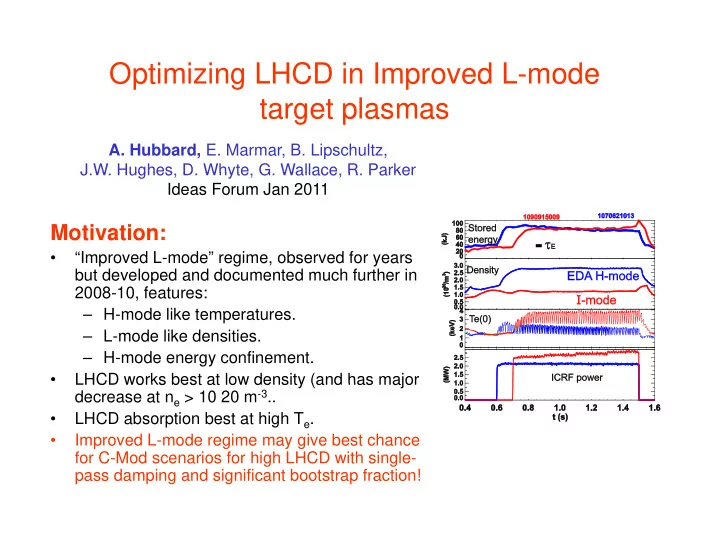

Optimizing LHCD in Improved L-mode t target plasmas t l A. Hubbard, E. Marmar, B. Lipschultz, J.W. Hughes, D. Whyte, G. Wallace, R. Parker J W Hughes D Whyte G Wallace R Parker Ideas Forum Jan 2011 Motivation: • “Improved L-mode” regime, observed for years but developed and documented much further in 2008-10, features: – H-mode like temperatures. H mode like temperatures – L-mode like densities. – H-mode energy confinement. • LHCD works best at low density (and has major LHCD works best at low density (and has major decrease at n e > 10 20 m -3 .. • LHCD absorption best at high T e . • Improved L-mode regime may give best chance for C-Mod scenarios for high LHCD with single- f C M d i f hi h LHCD ith i l pass damping and significant bootstrap fraction!
In 2010, coupled LHCD into 900 kA I-mode encouraging but needs development encouraging but needs development At density of nebar 1.3-1.4 x 10 20 • m -3 (~30% above n e limit in L- 3 ( 30% b li it i L modes), we did see increased non- thermals. But, still lower than is consistent with efficient current consistent with efficient current drive. • Directions to optimize: Di ti t ti i – Decrease I-mode density (likely by decreasing current. Unfortunately this also decreases P this also decreases P L-I , and T ped .) and T ) – Increase LH power (was 600 kW). – Decrease inner wall gap (increases HXR in L-modes.) HXR in L modes.)
Experimental Proposal • Scope out low density range for I-modes, vs current (at 0.9, 0.8, 0.7 MA). Try lower I p , which so far have not given good I-modes. Knobs to try: – Recent boronization (Mo radiation has been a problem at low density). – Neon seeding which may reduce Mo Neon seeding, which may reduce Mo. – Use cryopump. – Increase ICRF power to max before H-mode transitions. • Once steady “Improved L-mode” target is established, for lowest density at each I p , add LHCD at maximum available power. Monitor: – J(r) changes via MSE, polarimetry, V loop , sawtooth behaviour…. ( ) g , p y, loop , – Non-thermals via Hard X-rays, ECE – SOL profiles (probes, reflectometer). • Detailed analysis and simulation using TSC ACCOME and Detailed analysis and simulation using TSC, ACCOME and GENRAY/CQL3D to assess bootstrap and driven current, compare to expt. Use these to optimize future advanced scenarios, make predictions for capabilities using higher LH power when available.
Recommend
More recommend